Cold Water Fish
Care Guide
Tropical or Cold Water Fish?
The first decision to make is whether you want to keep fish which require a heater in the tank, or not.
Most tropical fish must be kept in temperatures ranging from 25° to 27°C, although a few species require their environment to be slightly warmer or cooler than this. Cold water fish are happy at normal room temperature for most homes, being quite comfortable at 15°C.
No matter which you choose, it is important to have a thermometer attached to the tank, in order to monitor extreme water temperature changes, whether this is caused by a fluctuation in the environmental temperatures, or a heater malfunction.
True Cold Water Fish
Throughout our information, we refer to fish who don't require a heater in their tank to thrive as 'cold water fish'. However, this is not strictly the case, and temperate fish tends to be a more appropriate description. True cold water fish would require a chiller in their tank, which would cost a lot more to buy and run than a heater. There are strong restrictions on true cold water fish being brought into the UK, due to their ability to survive in our rivers and predate upon native species. From here on in, though, we will describe our temperate, home loving, fish friends, as cold water fish, as that is what many of us have always known them as.
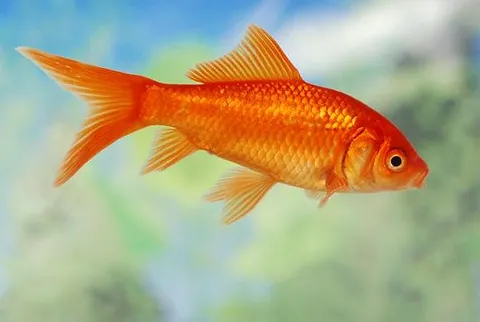
Common Goldfish & Variants
A variety of fish which will happily live in a tank without a heater are readily available. The Common Goldfish and its many varieties, such as the Shubunkin and the Comet, have an elongated flattened football shape, and tend to be a hardy species to keep.
Common goldfish are often viewed as best for beginner keepers since they are hardy enough to tolerate many newbie mistakes. These long-body fish can vary in colour from white to bright orange to dark brown. However, properly kept, they can grow up to 12 inches or longer, so a large tank is required.
Some fancy varieties, such as the Black Moor, Ranchu or Oranda, do not grow quite as large as the Common Goldfish. However, due to their wider bodies, they produce a similar amount of waste at their fully grown size of 8" as a larger variety, and so they still require a large aquarium with powerful filtration.
They can live in water with temperatures ranging from 12-26°C, with a pH of 6-8, which is very similar to tap water. The common goldfish doesn’t require a heater and needs only minimal care if living in a well filtered aquarium of 180 or more litres.
Bowls are not suitable homes for goldfish, they do not provide adequate space, lack proper filtration, and do not provide enough oxygen for the fish to survive.
The average lifespan of a goldfish is 10-15 years, but some varieties can live up to 30 years or more with proper care. The oldest recorded goldfish, Tish, lived to be 43 years old.

Fancy Goldfish
Fancy goldfish, with egg-shaped bodies, come in many varieties like Oranda (with head growth), Ranchu (rounded body), Ryukin (high back), and Black Moor (telescope eyes). They need large tanks with powerful filtration due to their waste production. Care should be taken with the species which have protruding eyes, as they tend to have poor vision so the faster species will outcompete them at feeding time. The species with protruding eyes can also be more prone to injury and therefore infection, so should only be kept with other slow moving, delicate species.
Tanks should be decorated with smooth objects, avoiding sharp rocks or plastic plants that could injure their fins. Smooth rocks, driftwood, and live plants (if they don't eat them) are good choices. Make sure decorations are large enough they can't swallow them. Use sand or larger pebbles for the bottom of the tank. While no heater is needed, they can't tolerate temperatures below 13°C and prefer 20-24°C. Strong filtration and pristine water quality are crucial for their well-being. Test the water regularly for ammonia, nitrite, and nitrate. Ammonia and nitrite should always be zero, and nitrate low (below 20 ppm).
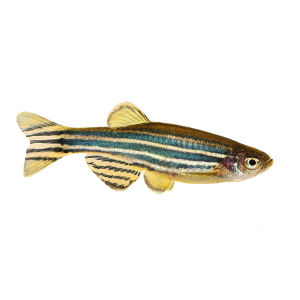
Minnow & Danio
White Cloud Mountain Minnows and Zebra Danios are popular choices for smaller, filtered aquariums, especially for beginners. White Clouds are known for their hardiness, tolerating a wider temperature range (18-22°C) than many tropical fish, making them truly cold-water tolerant. They have a lifespan of 5+ years, adding to their appeal.
Zebra Danios, while often sold as cold-water, prefer the warmer end of the spectrum (closer to 22°C) and are more accurately described as temperate. Both species are small, reaching only about 4cm, making them ideal for tanks under 80 litres.
Their schooling nature adds to their visual appeal, as they swim together in coordinated movements. While peaceful, Zebra Danios are more active, while White Clouds are more laid-back. Both appreciate planted tanks with open swimming space. Consider a minimum of 6 of each species for proper schooling behaviour.
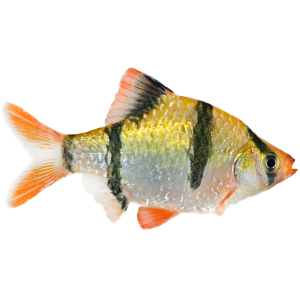
Barbs
Rosy Barbs, Golden Barbs, and Odessa Barbs offer vibrant colour and engaging behaviour to unheated aquariums, thriving in temperatures between 18-22°C. These active shoaling fish should be kept in groups of five or more, ideally more, to truly appreciate their social dynamics. Their playful "stand-offs" are more like displays of dominance than actual aggression, adding an entertaining element to the tank.
While these barbs are generally peaceful within their own species and with appropriate tank mates, their nippy nature makes them unsuitable companions for long-finned or slow-moving fish. Common and Fancy Goldfish are particularly vulnerable to fin nipping and should never be housed with these barbs. Good tank mates include other similarly sized and active cold-water fish, such as White Cloud Mountain Minnows, Zebra Danios, and other cold-water barb species.
A well-planted tank with open swimming areas will provide these barbs with an enriching environment. Consider a larger tank to accommodate their active swimming and social interactions.
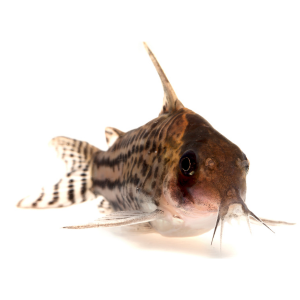
Peppered Corydoras
Peppered Corydoras are a unique and popular choice for unheated indoor aquariums due to their preference for cooler water temperatures. Unlike most other Corydoras species, which require tropical temperatures, Peppered Corys thrive in a range of 18-25°C, making them perfectly suited for many homes without aquarium heaters. It's important to note the "most" in that statement, as a few other cory species also tolerate cooler waters, though Peppereds are among the most commonly available. For example, the Marbled Cory can also adapt to slightly cooler temperatures.
However, the vast majority of Corydoras, such as the popular Bronze, Panda, and Sterbai Corydoras, are strictly tropical and need heated tanks. Therefore, Peppered Corys stand out as a great option for those looking to avoid a heater.
These small, bottom-dwelling catfish are social creatures and should be kept in groups of at least 4-5 individuals, though larger groups will result in more natural behaviours and a more engaging display. Peppered Corys are known for their peaceful nature and are generally compatible with other cool-water fish species.
When introducing Peppered Corys purchased from a tropical aquarium to an unheated tank, it's crucial to acclimate them slowly over a period of at least 12 hours, carefully matching the water temperature in the bag to the temperature of the destination tank to avoid temperature shock. This gradual acclimation is essential to minimize stress and ensure a smooth transition to their new, cooler environment.
These corydoras enjoy a sandy or fine gravel substrate and a well-planted tank with hiding places, mimicking their natural habitat and providing them with security. They are primarily bottom-feeders, scavenging for food, so a varied diet of sinking pellets, flakes, and frozen foods is ideal.

Weather Loach
Several loach species are suitable for unheated aquariums, most notably the Weather Loach (Misgurnus anguillicaudatus). This hardy and peaceful fish thrives in temperatures ranging from 15-25°C, making it an excellent choice for those without aquarium heaters.
While not the most colourful or flashy fish, the Weather Loach possesses a unique charm and can grow to an impressive 10 inches in length, making it a captivating addition to a larger tank. One of its most remarkable characteristics is its ability to survive for several hours outside of water, a handy trait should it ever escape (making well-fitting lids a must!).
Adding to their intrigue, Weather Loaches are known for their sensitivity to barometric pressure changes and are said to "predict" approaching storms with increased activity and unusual swimming patterns. This fascinating behaviour, combined with their peaceful temperament and hardiness, makes the Weather Loach a truly unique and rewarding aquarium inhabitant. They prefer a soft substrate, like sand, and plenty of hiding places amongst rocks and driftwood.
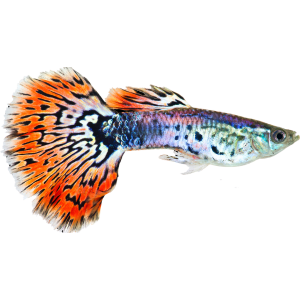
Guppies, Mollies & Platies
Guppies, Mollies, and Platies, while popular and readily available, require careful consideration when it comes to temperature. These livebearing fish, while often perceived as "hardy," are not as resilient to fluctuating or cooler temperatures as they once were. Selective breeding for vibrant colours, finnage, and other desirable traits has, unfortunately, often come at the cost of overall hardiness. The vast majority of these fish available in the aquarium trade are now captive-bred, and while this has benefits in terms of reducing pressure on wild populations, it also means they've been raised in consistently warm, ideal conditions. Wild-caught specimens, which were historically more robust, are now rare.
Because of this, keeping guppies, mollies, and platies in unheated aquariums is strongly discouraged. While they might survive for a time, they will likely be stressed and more susceptible to diseases like ich (white spot disease) and other parasitic or bacterial infections. Their immune systems are compromised when kept at temperatures below their ideal range. Optimum temperatures for these fish generally fall between 24-28°C (75-82°F). Lower temperatures can also negatively impact their reproductive capabilities.
It's important to distinguish between "hardy" and "tolerant." These fish might tolerate slightly cooler temperatures for short periods, but they won't thrive and their long-term health will suffer. Providing a heater and maintaining stable temperatures within their preferred range is crucial for their well-being, longevity, and vibrant colours. Investing in a reliable aquarium heater and thermometer is essential for responsible fish keeping with these species.
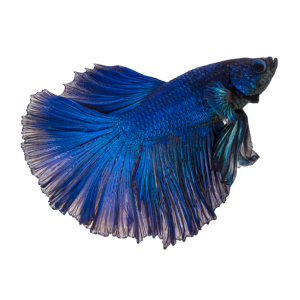
Siamese Fighting Fish aka Betta
Siamese Fighting Fish, also known as Betta fish, are often mistakenly portrayed as suitable for small, unheated bowls. This couldn't be further from the truth. In their natural habitat, these beautiful fish inhabit warm, shallow rice paddies with ample oxygen, stable temperatures, and gentle water flow.
Responsible Betta care involves replicating these conditions as closely as possible. A heated and filtered tank of at least 15 litres is essential to provide them with the space and stable environment they need to thrive. Maintaining a consistent temperature between 24-26°C is crucial for their health and well-being.
Keeping a Betta in an unheated environment will lead to a lethargic fish with a weakened immune system, making them susceptible to disease. Therefore, providing a heater is not just recommended, it's a necessity for responsible Betta ownership. With proper care, including a heated and filtered tank, appropriate tank mates (if desired), and a varied diet, Bettas can truly flourish and display their vibrant colours and personalities.
Summary & Shopping List
Here's a shopping list for setting up a cold water fish tank, keeping in mind that goldfish need larger tanks than many people realize:
Essentials:
Aquarium: A large tank is the most important purchase. For fancy goldfish (the rounder bodied varieties), aim for at least 20 gallons per fish. For common or comet goldfish (the longer, slimmer bodied types), you'll need even more space, ideally 40 gallons per fish, as they grow much larger. Bigger is always better for goldfish.
Filter: Goldfish produce a lot of waste, so a powerful filter is a must. A canister filter is highly recommended for its superior filtration capacity. Choose a filter rated for a tank significantly larger than your actual tank size.
Gravel or Sand: Use smooth gravel or sand as a substrate. Avoid small gravel that goldfish could ingest. Sand is often considered the safest and most natural option.
Decorations: Choose smooth, non-abrasive decorations. Avoid anything with sharp edges that could injure your goldfish. Smooth rocks, driftwood, and live plants (if the goldfish won't eat them) are good options. Ensure decorations are large enough that they can't be swallowed.
Lighting: Goldfish don't require special lighting, but a light can help you view them better and will benefit any live plants you choose to include. A standard aquarium light is fine.
Heater (Optional but Recommended): While goldfish can tolerate cooler temperatures, a heater can help stabilize the temperature and prevent fluctuations, which can be stressful. Set it to the lower end of their comfortable range (around 68-75°F or 20-24°C). This is particularly important for fancy goldfish varieties.
Thermometer: To monitor the water temperature.
Fish Net: For safely catching and moving your goldfish.
Water Conditioner: To remove chlorine and chloramine from tap water, making it safe for your fish.
Test Kit: A liquid test kit to monitor ammonia, nitrite, and nitrate levels in the water. This is crucial for maintaining healthy water quality.
Gravel Vacuum: For cleaning the substrate and removing waste.
Buckets: For water changes. Use buckets that are only for aquarium use.
Food and Supplements:
Goldfish Food: Choose high-quality goldfish flakes or pellets as the staple of their diet. Supplement with live or frozen foods like bloodworms or brine shrimp a few times a week. Vegetables like blanched spinach, peas, or zucchini are also beneficial.
Food Soaking Container: Soaking dry food for a few minutes before feeding can help prevent swim bladder issues.
Optional but Helpful:
Automatic Feeder: Can be useful if you're going to be away.
Air Pump and Air Stone: Can provide additional oxygen to the water, especially in warmer temperatures.
Stress Coat: Reduce stress in fish and promote the healing of wounds with API Stress Coat, a multi functional aquarium conditioning treatment that removes harmful chemicals from the water and uses the healing power of Aloe Vera to help regenerate damaged tissue.
ESHa Optima: Typically found in tropical rivers, streams and lakes, the unique combination of essential components found in eSHa Optima Fish Health Boosting & Conditioning Treatment are blended with minerals, vitamins, trace elements and natural growth enhancers to provide aquarium pets with the benefits they would enjoy in the wild.
Before You Buy Your Goldfish:
Research: Learn about the specific needs of the goldfish variety you want to keep. Fancy goldfish, in particular, have some specific care requirements.
Cycle Your Tank: It's crucial to cycle your tank before adding any fish. This establishes beneficial bacteria that will break down waste. This process takes several weeks. Research how to cycle an aquarium. Products such as Easy Life, a biological filter medium, can speed up this process.
This list should give you a good starting point for setting up a healthy and happy home for your goldfish! Remember that responsible goldfish keeping requires a commitment to providing adequate space and maintaining excellent water quality.

